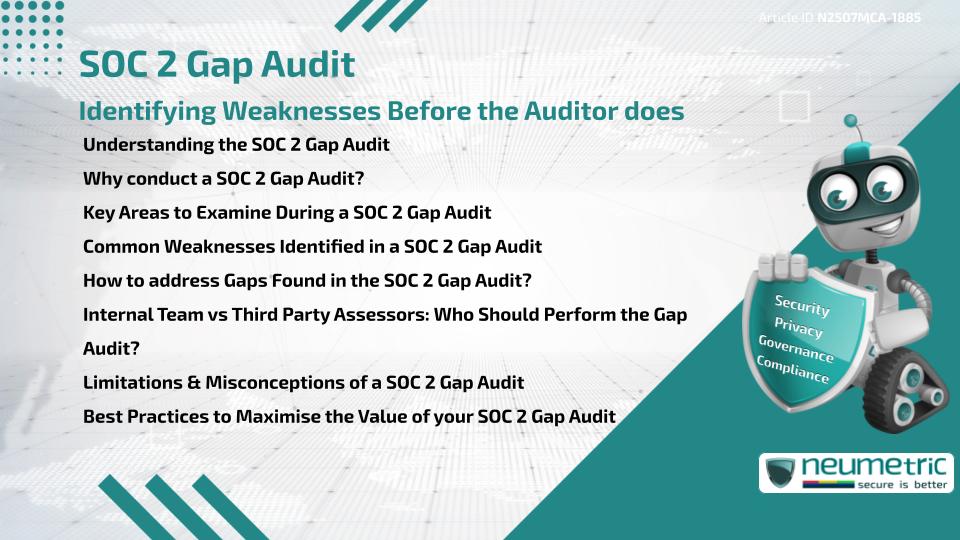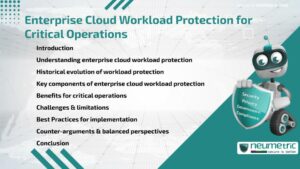Table of Contents
ToggleIntroduction
A SOC 2 Gap Audit is a critical preparatory step for any service organisation aiming to achieve [System & organisation Controls 2] [SOC 2] compliance. It helps identify weaknesses in existing controls & operational processes before an external auditor does. By uncovering these issues early, companies can avoid surprises, reduce remediation costs & confidently face the formal SOC 2 Audit. The gap Audit not only validates readiness but also boosts internal awareness of Risk Management & control practices.
In this article, we explain what a SOC 2 Gap Audit is, why it is important & how it can help organisations pinpoint security & compliance gaps before they escalate. We also review common issues, explore Best Practices & provide a balanced view of its benefits & limitations.
Understanding the SOC 2 Gap Audit
The SOC 2 Gap Audit is an informal internal or Third Party review that assesses how well an organisation aligns with the SOC 2 Trust Services Criteria-Security, Availability, Processing Integrity, Confidentiality & Privacy. It is not a Certification but a diagnostic tool that flags any shortcomings in current systems, processes & documentation.
This gap Audit provides a practical roadmap for organisations that are either preparing for their first SOC 2 examination or revisiting controls after a significant operational change. Unlike the formal Audit, which results in a SOC 2 Report, the gap Audit remains an internal document unless shared voluntarily.
Why conduct a SOC 2 Gap Audit?
Performing a SOC 2 Gap Audit offers several advantages:
- Early Detection of Deficiencies: Finding problems before an External Audit prevents last-minute fixes.
- Resource Planning: It helps allocate budget & time for remediation efforts.
- Internal Alignment: Facilitates cross-department collaboration & readiness.
- Client Trust: Demonstrates proactive compliance, which can be shared with clients & Stakeholders.
- Audit Efficiency: Reduces surprises & shortens the duration of the formal Audit.
Without a gap Audit, organisations often enter audits with blind spots that could delay Certification or expose them to reputational damage.
Key Areas to Examine During a SOC 2 Gap Audit
A thorough SOC 2 Gap Audit should examine controls related to the five Trust Services Criteria. Key focus areas include:
- Access Controls: Who has access to sensitive Systems & Data?
- Change Management: Are there procedures to handle software & system updates?
- Incident Response: Is there a documented & tested plan in place?
- Vendor Management: Are Third Party Risks assessed & monitored?
- Data Retention & Disposal: Are Policies in place for secure data handling?
Reviewing these areas in depth helps determine if your existing Policies meet SOC 2 expectations or if updates are needed.
Common Weaknesses Identified in a SOC 2 Gap Audit
The most frequent gaps found in a SOC 2 Gap Audit include:
- Inadequate Documentation: Policies exist but are not formally written or communicated.
- Weak Access Controls: Lack of two-factor authentication or role-based access.
- No Security Awareness Training: Employees are not educated on security protocols.
- Poor Logging Practices: Incomplete or unmonitored system logs.
- Unclear Incident Response Plans: Plans are outdated or untested.
Addressing these issues early ensures smoother compliance later.
How to address Gaps Found in the SOC 2 Gap Audit?
After identifying weaknesses, organisations should take the following steps:
- Prioritise Issues by Risk Level: Focus on high-Risk areas first.
- Assign Responsibilities: Define who will lead each remediation effort.
- Set Clear Deadlines: Keep projects on schedule to meet Audit timelines.
- Update Documentation: Ensure all Policies & procedures are well-documented.
- Run a Follow-Up Review: Conduct a second Gap Analysis to confirm remediation.
This structured approach ensures Continuous Improvement & Audit readiness.
Internal Team vs Third Party Assessors: Who Should Perform the Gap Audit?
The SOC 2 Gap Audit can be conducted internally or by an external specialist. Each option has its merits:
- Internal Review: More cost-effective, but may lack objectivity.
- Third Party Review: Offers independent insights, industry Best Practices & unbiased analysis.
Choosing the right option depends on available expertise, time constraints & organisational maturity.
Limitations & Misconceptions of a SOC 2 Gap Audit
Despite its usefulness, the SOC 2 Gap Audit is often misunderstood:
- It’s Not a Guarantee: A gap Audit does not ensure SOC 2 Certification.
- Not legally Binding: Findings are not regulated or enforced by authorities.
- No Official Report: It does not replace the formal SOC 2 attestation.
Understanding these limitations prevents over-reliance & keeps expectations realistic.
Best Practices to Maximise the Value of your SOC 2 Gap Audit
To get the most out of your SOC 2 Gap Audit, consider the following tips:
- Use a Standardised Checklist: Align with frameworks like NIST SP 800-53 or CSA Cloud Controls Matrix.
- Involve Cross-Functional Teams: Include IT, legal, HR & operations in the review.
- Document Everything: Evidence is crucial for both internal reviews & external audits.
- Stay Current: Regularly review Policies to adapt to evolving Threats & standards.
- Seek External Validation: An external opinion can uncover missed gaps.
These practices help ensure that the gap Audit remains relevant & effective.
Takeaways
- A SOC 2 Gap Audit is an essential pre-Audit process that highlights security & compliance deficiencies.
- It reduces the Risk of surprises during the actual SOC 2 Audit.
- Common issues include weak documentation, Access Control flaws & untested Incident Response plans.
- Both internal & Third Party reviews offer unique benefits.
- Limitations exist, but with the right approach, a gap Audit can greatly streamline your compliance efforts.
FAQ
What is a SOC 2 Gap Audit?
A SOC 2 Gap Audit is an internal or Third Party assessment that identifies compliance gaps before a formal SOC 2 Audit begins.
Is a SOC 2 Gap Audit mandatory?
No, it is not required, but it is highly recommended to improve Audit readiness & reduce the Risk of failure.
How long does a SOC 2 Gap Audit take?
It typically takes between one (1) and four (4) weeks depending on the size & complexity of the organisation.
Can we do a SOC 2 Gap Audit internally?
Yes, but ensure the team has adequate knowledge of SOC 2 requirements to conduct an effective assessment.
How often should a SOC 2 Gap Audit be performed?
Ideally, before every formal SOC 2 Audit or after significant changes to systems or operations.
What happens after a SOC 2 Gap Audit?
You should prioritise remediation efforts based on the Audit Findings & prepare for a follow-up review.
Is there a Standard checklist for SOC 2 Gap Audit?
Many use industry frameworks like NIST or CSA CCM as benchmarks.
Will a SOC 2 Gap Audit guarantee SOC 2 compliance?
No, it identifies issues but does not replace the formal Audit or assure certification.
What is the cost of a SOC 2 Gap Audit?
Costs vary widely depending on scope & whether an internal or external party performs the Audit.
Need help for Security, Privacy, Governance & VAPT?
Neumetric provides organisations the necessary help to achieve their Cybersecurity, Compliance, Governance, Privacy, Certifications & Pentesting needs.
Organisations & Businesses, specifically those which provide SaaS & AI Solutions in the Fintech, BFSI & other regulated sectors, usually need a Cybersecurity Partner for meeting & maintaining the ongoing Security & Privacy needs & requirements of their Enterprise Clients & Privacy conscious Customers.
SOC 2, ISO 27001, ISO 42001, NIST, HIPAA, HECVAT, EU GDPR are some of the Frameworks that are served by Fusion – a SaaS, multimodular, multitenant, centralised, automated, Cybersecurity & Compliance Management system.
Neumetric also provides Expert Services for technical security which covers VAPT for Web Applications, APIs, iOS & Android Mobile Apps, Security Testing for AWS & other Cloud Environments & Cloud Infrastructure & other similar scopes.
Reach out to us by Email or filling out the Contact Form…





